Last Updated on May 27, 2021 by Danny
Read our in-depth guide to know about the different types of drums around the world.
There are majorly 8 Types of drums which include
- Drum sets
- Marching Drums
- Bongos/congas
- Goblet Drums
- Frame Drums
- Tongue Drums
- Timpani
- Steel Drums
We start with western drum sets that are well known and slowly venture into rare African and hand drums before ending with marching band drums. If you want to play a percussion instrument and want to know the available choices, this would be an excellent article for you.
If not, this article will still help you better understand the various types of drums out there.
Types of Drum Sets
Acoustic Drum Set
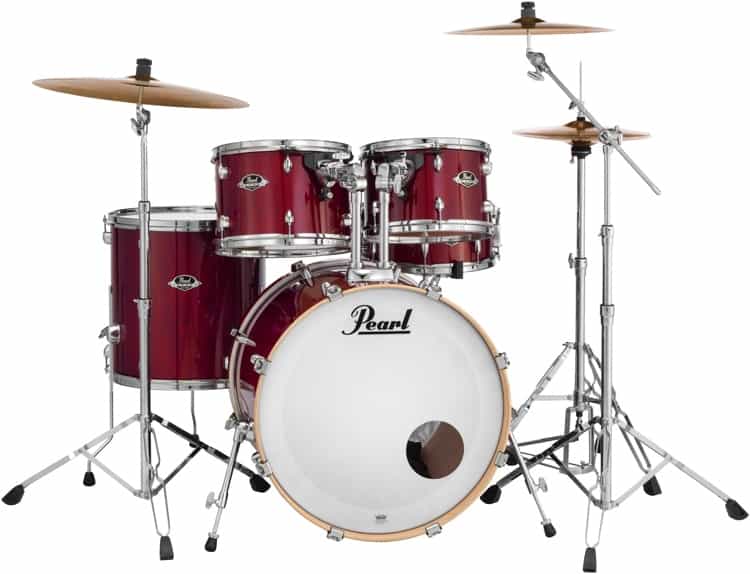
An acoustic drum set is what typically comes to someone’s mind when they think of drums. Nearly all popular genres of music include them. They come in various sizes and configurations depending on the genre of music and the drummer’s preference. Ludwig, TAMA, DW, and Gretsch are some of the most recognized acoustic drum brands known for their tone and durability.
Power/Rock
As the name states, these types of drums are typically used in rock or heavy metal genres and can pack a punch.
These drum kits typically have a large bass drum; usually 22″ x18″ big. In addition to these, a typical rock kit has three toms of sizes 12″,13″, and 16″ along with a snare drum that’s usually 14″ big. However, each drummer will customize his kit, and therefore, the setup will vary across artists. Power/Rock kits are larger than other kits and, therefore, louder, more powerful, and pack a lot of bass.
Fusion
As you can deduce from the name, a fusion kit is meant for songs that are an amalgamation of different genres. You can mix any genre of your choice, and the possible configurations of the drums for these are near endless.
A fusion drum kit usually has three tom-toms of 10″, 12″, and 14″ along with a kick drum that’s usually 20″ or 22″. The snare drums are entirely up to the drummer’s preference. While the smaller size makes them less powerful than the rock kits, they have higher responsiveness, allowing the drummer to play complex sequences.
Jazz
Jazz drum kits are the smallest and lightest; therefore, they have the lowest power. However, the lack of power is entirely compensated by their extremely high responsiveness, which allows drummers to play incredibly intricate rhythms.
While the drums have a diameter similar to that of fusion drums, they are shallower in-depth, making them sound more natural. However, a jazz kick drum is smaller and shallower than a fusion kit, typically 18″ x14″ big.
Electronic Drum Set
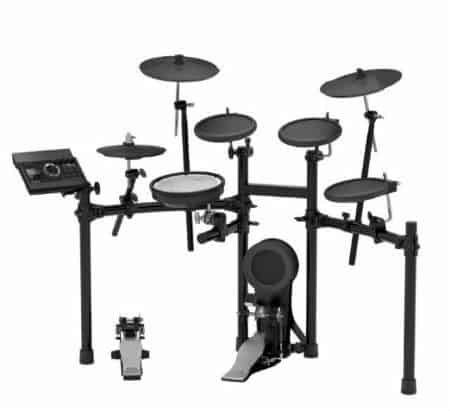
An electronic drum consists of drum pads, cymbal pads, and a drum module. The drum and cymbal pads have sensors that record when struck and pass a signal to the drum module (the brain), converting the signal into a sound.
These drum kits have many advantages over your acoustic drum kit. They are quiet and are therefore perfect for practicing at home. There is also an endless library of sounds you can use. Therefore, you play anything from hardcore rock to fast-paced jazz with a single electronic drum. You could even add your custom sounds to it.
The technology behind these drums has also improved over the years. The sensors can now measure your stroke’s location and force and alter the note based on that.
Electronic drums mainly lose to acoustic drums in their playability; this is because rubber pads cannot even come close to an actual head’s responsiveness.
However, there are now mesh heads for electronic kits that can better replicate actual heads. Some of the most well known electronic drum manufactures are Yamaha, Roland, and Alesis.
There is a further evolution of electronic kits, and that is virtual drum kits. These are not actual kits but rather software that can replicate drum kits and produce the beats and rhythms you desire.
Auxiliary Drum Sets
Auxiliary drum kits are usually an incredible assortment of different elements. They usually consist of an electronic kit with multiple extras attached to them, including bells, blocks, chimes, drums, etc. Their unique assortment and adaptability make them extremely suitable for experimental genres.
You can use these types of drums for solo performances and as a part of a band, usually with a primary kit. The only things preventing many people from using auxiliary kits are their high cost and complexity.
Triggers
Triggers are sensors that you can attach to the drum head of your auxiliary drum kit—thereby allowing you to combine the feel and resonance of an acoustic drum kit with an electronic drum’s capabilities. Each time you strike your drums, the sensor detects the vibration and sends a signal to the drum module. The module can then play any sound of your choosing. This mixture of acoustic and digital notes helps increase the range of your sonic capabilities. You can use drum triggers in live performances to improve the clarity of your song. They are handy in recording as they remove the need for microphones.
Types of Hand Drums
Hand drums are one of the oldest types of percussion instruments in the world. They are prevalent across multiple ancient cultures worldwide, with each having its unique characteristics and sound.
Hand drums are a powerful tool in any drum kit due to their unique tone and cultural significance. As you would expect, hand drums are played primarily with your hands; you can also strike with tippers and mallets.
Congas
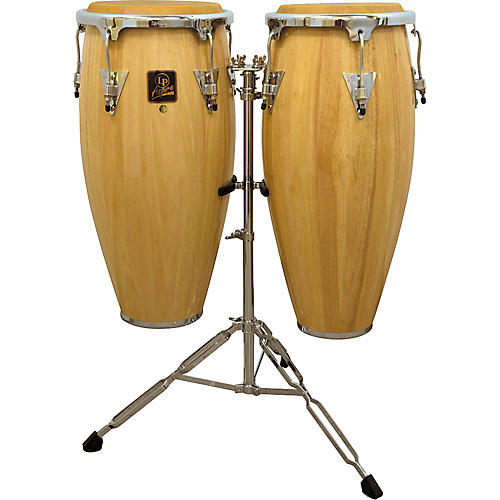
These are the tall drums that most people assume to be from Cuba. Still, they originated in the Congolese Bantu area in Africa. They are typically made of wood and resemble the conical ‘Makuta’ drums, which are also from Africa.
These drums are usually sold in pairs or triplets, with each drum being of a different size so that the drummer gets a broader range of notes. ‘Quito’ is the smallest drum and therefore has the highest notes. The ‘Conga/tres’ is the medium-sized one, and ‘Tumba’ is the largest and has the lowest pitched notes.
A person playing the Congas is known as a conguero and will produce the carnival-style rhythms using a combination of both hands and fingers.
Top 3 Congas to check out
[amazon bestseller=”congas” order_items=”7″ template=”table” button_text=”Check the Reviews” filterby=”title” filter=”LPM198-PR, Pearl, Gibraltar, Evans” filter_type=”exclude”]Bongos
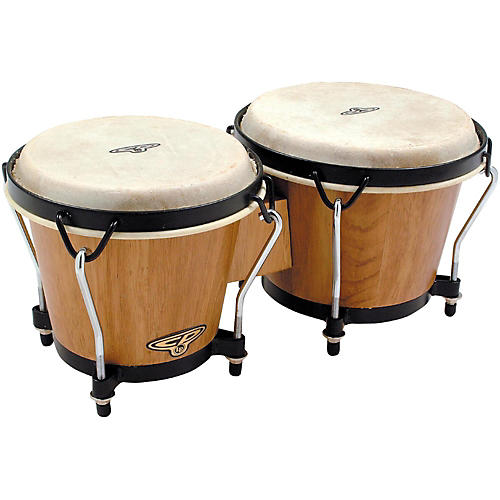
Bongos are Afro-Cuban drums which are small and often played along with Congos. They are one of the most well-known hand drums and probably have one of the hardest names to pronounce correctly. Bongos usually consist of a pair of drums, a smaller ‘macho’ drum, and a larger ‘hembra’ drum.
The types of drums are made of conical or slightly tapered wooden shells. Still, manufacturers have recently begun making bongos out of metal and fiberglass. Therefore, there is a noticeable variance of tones between brands.
Drummers use the fingertips and palm of their hands to play the bongos. Bongos are a staple in salsa and cha-cha music because of the high energy and momentum of their beats. Still, there are many other different techniques for playing bongos.
Top 3 Bongos to check out
[amazon bestseller=”bongos” order_items=”5″ template=”table” button_text=”Check the Reviews” filterby=”title” filter=”rockjam, Remo” filter_type=”exclude”]Tabla
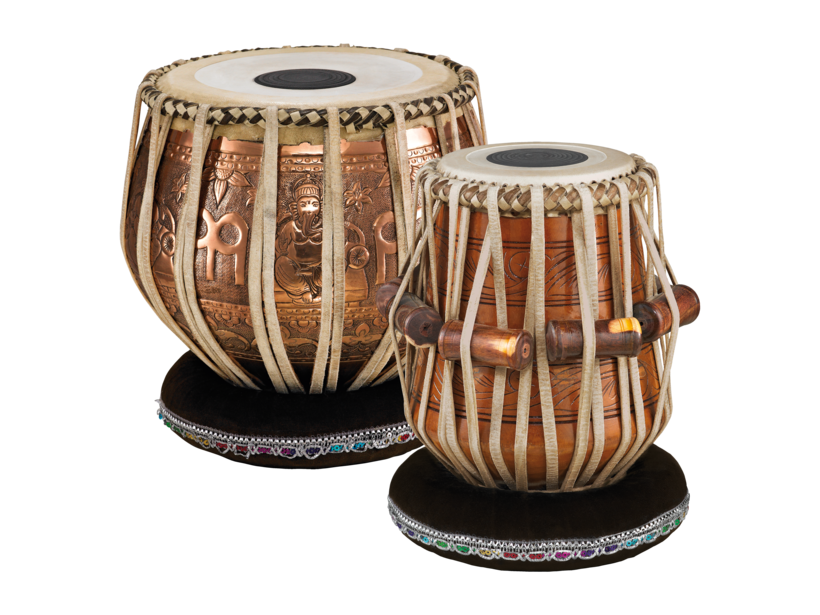
Tabla is a drum of Indian origin and too prevalent in Indian classical music. Tabla drums consist of two drums with tapered cylindrical shells and covered with animal skin. The ‘dayan’ is the smaller one of these drums and has a teak or rosewood shell. Therefore, ‘Dayan’ to produce higher notes. The ‘bayan’ is the larger drum and typically has a brass metal shell; it can produce more resonant sounds better. The tabla is played with fingers and the heel of the hand.
Frame Drums
These are also a ubiquitous category of drums worldwide. A frame drum is made of a simple frame and a drum skin. The skin is traditionally made from animal hide, and the drum produces different notes based on where you hit it. The edges of the drum tend to produce high pitch notes while the center has deep notes.
Pandeiro
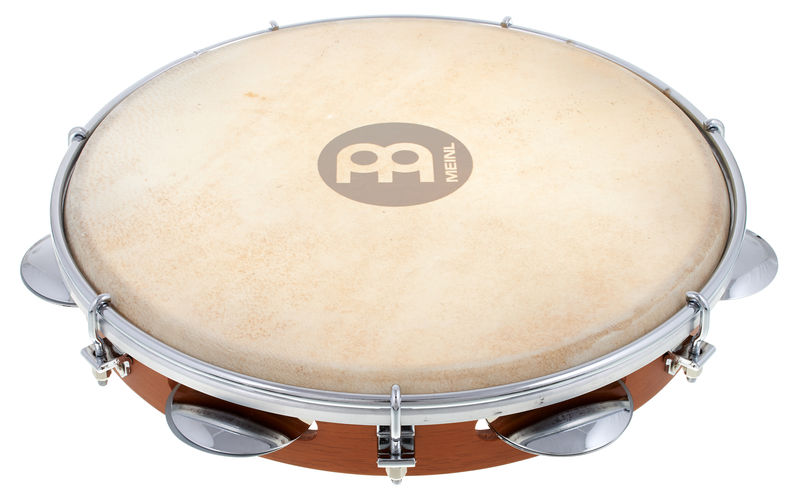
The pandeiro is a Brazilian drum that bears a resemblance to the tambourine. It consists of a thin wooden shell with an animal skin drumhead; the outer shell also has steel or copper cymbals inserted.
Pandeiro is prevalent in Capoeira martial dances( an Afro-Brazilian martial art). Its low pitch and subtle notes sound great with vocals and other percussion instruments.
The pandeiro is typically between 8 and 12 inches and is played with the thumbs, fingers, and palms on the drum head. The drummer usually holds it up with one hand while striking it with the other hand. You can also use your fingers to apply on the platinelas (cymbals)
Tambourine
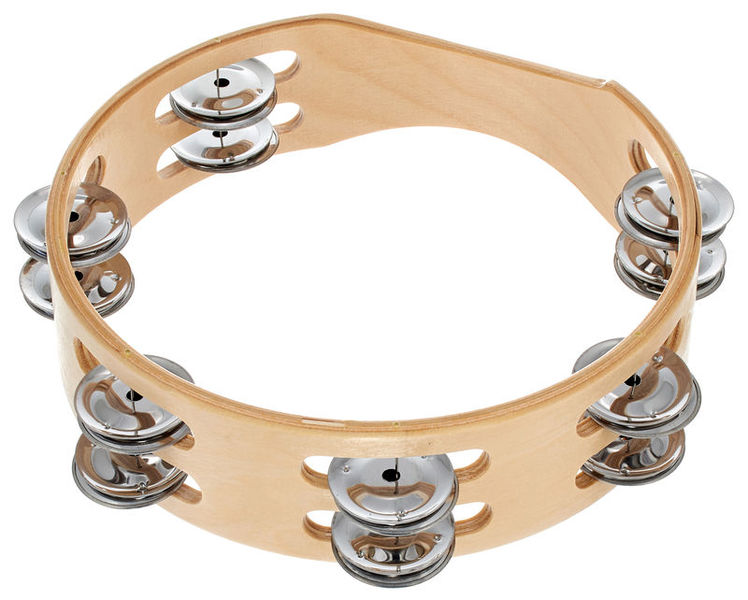
The tambourine is the most popular among frame drums and was initially conceived in Europe during the 16th century. It’s incredibly similar to the pandeiro but has smaller cymbals that are known as zills. The tambourine is prevalent in multiple regions due to its sound and portability.
The early tambourines were small hand drums with a single or dual layer of animal intestine or skin stretched over a shallow shell. The cymbals were only added to it in modern times and help improve the rhythmic parts of a sequence.
There are plenty of different models of tambourine. Some have drum heads while others don’t; some are tunable while others aren’t. The ones without heads are played by striking the outer frame with either your hand or a stick. There are even ones with multiple layers of cymbals.
Bodhran
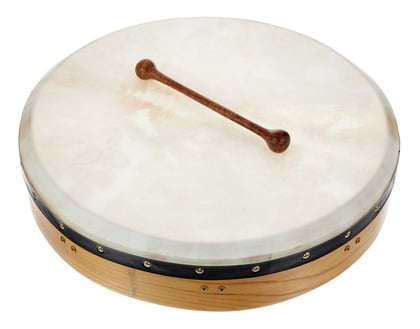
The Bodhran is an Irish/Celtic frame drum made from wood and had a goatskin drumhead. However, in recent years, companies have started using plastic shells and artificial skins to make bodhrans.
The Bodhran has skin on only one side, and the shell is usually between 12 and 24 inches wide while being between 4 and 8 inches deep. Having just a single skin allows the drummer to control the pitch by moving his hand inside the Bodhran.
You can use your hand or by using beaters known as tippers to play it. Usually, the drum can be tuned using the crossbar and hex key to adjust the drum skin’s tension. However, some bodhrans are untunable.
Goblet Drums

Goblet drums are a broad class of drums that get their name from their goblet like shape. These drums are ancient, with some dating to as far back as 3600BC.
Darbuka is an example of a goblet drum. It originated in the Middle East and has been traditionally used in Africa, Eastern Europe, and the Middle East. Drummers hold the darbuka under one arm and play with the fingers and palms of their hands.
Goblet drums are made of various materials, including wood, clay, or metal. The drums are hollow shelled and produce a different note depending on where you hit them. Hitting the rim produces a sharp and bright note, while striking the center produces a more powerful note with enhanced resonance.
African Drums
African drums have one of the oldest histories and are deeply embedded in African traditions. While we are used to seeing them being used in peppy numbers and dance music, they hold a sacred and symbolic place in many African rituals and ceremonies.
Djembe

Djembe is an extremely popular hand drum that originated in West Africa. You can use it in a diverse range of genres due to its wide range of pitches.
The goblet-shaped shells are typically made out of a single piece of hollowed-out wood. The Lenge tree trunk is the lumber preferred by the Mandinka people, the Djembe creators, due to its tonality and spiritual significance. When you strike the middle of the drum, the upper chamber produces the low bass sounds while the lower section projects it out.
Traditionally they have goatskin heads( shaved or unshaved), but few people also use synthetic heads. The goatskin gives the Djembe its signature high pitched tone; this is produced when the drummer strikes the drum’s edge with his hand. Initially, the drums are rope-tuned, but there are mechanically tuned Djembe available now.
Talking Drum

These drums are one of the oldest instruments from West Africa and can be traced back to the Ghana Empire in the 9th to 11th centuries.
African griots used to play these drums while telling stories and making announcements in villages. They were an essential part of mass communications as villagers did not have the time to read and write.
The method of playing the talking drum is unique. You have first to wrap your hand around the instrument and squeeze it intermittently. Then you have to beat the animal’s skinhead with a mallet. The squeezing causes the outer ropes that connect the skin to shift, thereby causing the skin to wrap and produce a different pitch. You could also use a striker to change the pitch. This squeezing and change in pitch gave rise to the name ‘talking’ drum.
Udu
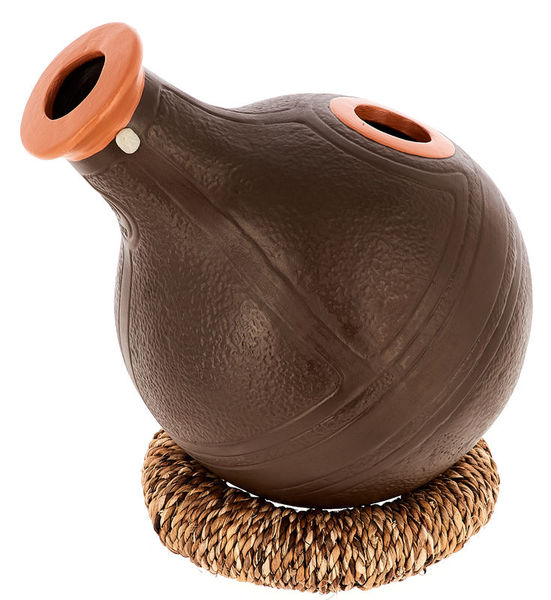
The udu is a clay-based drum that originated in Nigeria. The name comes from a language known as Igbo and means either a pot or a vessel.
The udu differs quite a lot from typically African clay water pots due to an additional circular hole on its side. There are variations of udu with one or two chambers. Women from the Igbo tribe are traditionally responsible for collecting and bringing drinking water. Therefore, udu is common in female ceremonies.
You can play udu with multiple techniques. You can strike the side hole with your palm and cover the top hole with your other hand. Doing so creates an eerie but soothing note that the Igbo tribesmen believe to be ancestral voices. You could also strike the top hole with your hand or play with your fingers on the body. You could also add a little water to the pot to alter the pitch of the note produced.
Types of Drums in a Marching Band

Drums are an essential part of marching bands as they provide the tenth and tempo that helps coordinate the whole thing. They are all quite varied in their function, shape, and size. However, they have to use a harness or a stand to mount to the musician securely. Thereby is to ensure a tone and prevent any accidents caused by the instrument being dropped.
Marching Snare

These are the drums that seem similar to your typical snare but are very different. They have a much deeper note than your standard snare and are made from Kevlar, the material you find in bulletproof vests. The Kevlar makes these drums extremely durable, and therefore marching snares can high tensions. This allows the drums to have a loud and piercing note. These drums are typically by themselves, and drummers use two drumsticks to play on them.
Multi-Tenor
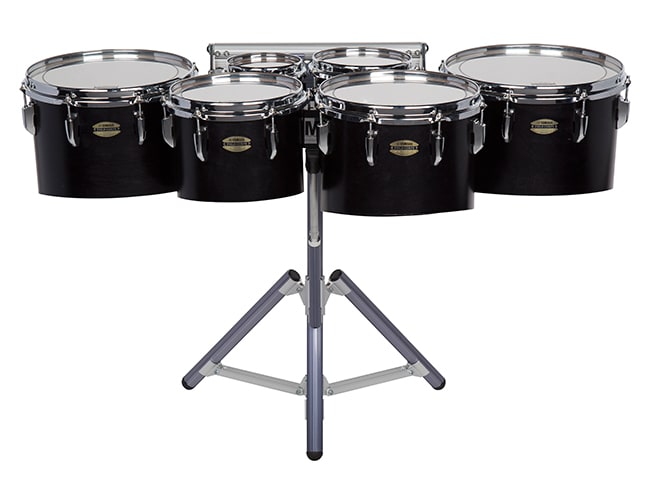
The multi-tenor drums are available in various configurations; the most common ones consist of 4 to 6 types of drums. They are also known as quads, quints, or squints (four, five, and six) based on the number of drums they have. All the individual drums are linked together and attached to a harness to improve stability.
These drums have a higher-pitched voice and are usually played with a pair of drumsticks or mallets. In addition to the main drums, these sets can also have tiny and tightly tuned accent drums. These drums are known as shots or spocks and have a bright and clean tone.
Bass Drum

These are probably the most recognizable of all marching band drums and are the largest drums in the ensemble. Bass drums have the lowest pitch of all the drums due to their large diameter and depth.
The large size of the drum requires additional shoulder straps for the drummer to support its weight. Typically, the drummers use a single soft mallet to provide a booming but smooth note rhythmically. There are multiple sizes of bass drums available, which means there is a range of pitches available. This allows you to choose a bass drum that is best suited to your band.
Front Ensemble

The front ensemble or front pit is a stationary setup that consists of various percussion instruments. This includes everything from bass drums, drums sets, cymbals, frame drums to the marimba, woodblock, and other auxiliary instruments.
The cymbals are typically massive, and you can use multiple techniques to play them. When they are stricken together, they produce a crashing sound, while tapping them together produces a more subtle note. The wooden blocks are typically made from teak and produce a bright beat when hit.
The ensemble can also include bells or glockenspiel, which produce chime-like bright tones when stricken with a hard mallet. Glockenspiel is an instrument that is similar to the xylophone but has metal plates or tubes instead of the wooden ones on the xylophone. The marimba is also like a xylophone, but it has resonator pipes beneath the keys, which amplify and project the sound more. These percussion instruments form a part of the front ensemble as they are too massive to be carried around.
Summary
While this might seem like a detailed and complete list of drums, this article barely scratches the surface. Each civilization and region has its idea of a percussion instrument; this has resulted in a wide variety of drums. Hopefully, this article informed and excited you about the different types of drums out there.